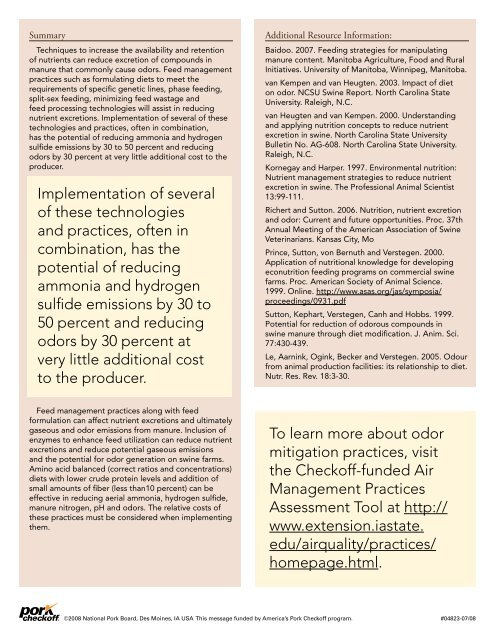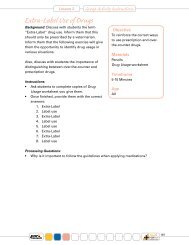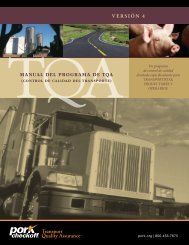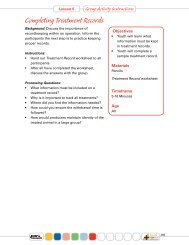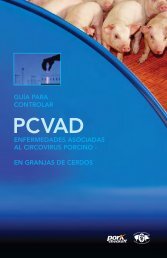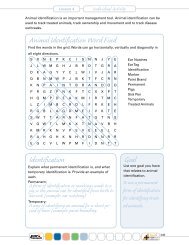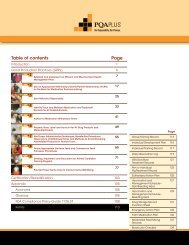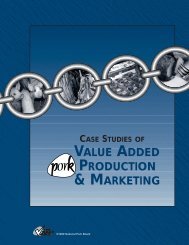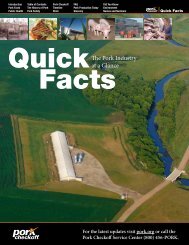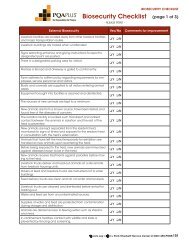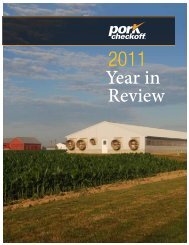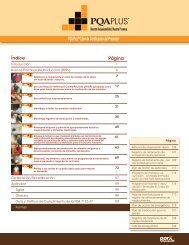Feed Management Practices to Minimize Odors from Swine ...
Feed Management Practices to Minimize Odors from Swine ...
Feed Management Practices to Minimize Odors from Swine ...
Create successful ePaper yourself
Turn your PDF publications into a flip-book with our unique Google optimized e-Paper software.
Summary<br />
Techniques <strong>to</strong> increase the availability and retention<br />
of nutrients can reduce excretion of compounds in<br />
manure that commonly cause odors. <strong>Feed</strong> management<br />
practices such as formulating diets <strong>to</strong> meet the<br />
requirements of specific genetic lines, phase feeding,<br />
split-sex feeding, minimizing feed wastage and<br />
feed processing technologies will assist in reducing<br />
nutrient excretions. Implementation of several of these<br />
technologies and practices, often in combination,<br />
has the potential of reducing ammonia and hydrogen<br />
sulfide emissions by 30 <strong>to</strong> 50 percent and reducing<br />
odors by 30 percent at very little additional cost <strong>to</strong> the<br />
producer.<br />
Implementation of several<br />
of these technologies<br />
and practices, often in<br />
combination, has the<br />
potential of reducing<br />
ammonia and hydrogen<br />
sulfide emissions by 30 <strong>to</strong><br />
50 percent and reducing<br />
odors by 30 percent at<br />
very little additional cost<br />
<strong>to</strong> the producer.<br />
Additional Resource Information:<br />
Baidoo. 2007. <strong>Feed</strong>ing strategies for manipulating<br />
manure content. Mani<strong>to</strong>ba Agriculture, Food and Rural<br />
Initiatives. University of Mani<strong>to</strong>ba, Winnipeg, Mani<strong>to</strong>ba.<br />
van Kempen and van Heugten. 2003. Impact of diet<br />
on odor. NCSU <strong>Swine</strong> Report. North Carolina State<br />
University. Raleigh, N.C.<br />
van Heugten and van Kempen. 2000. Understanding<br />
and applying nutrition concepts <strong>to</strong> reduce nutrient<br />
excretion in swine. North Carolina State University<br />
Bulletin No. AG-608. North Carolina State University.<br />
Raleigh, N.C.<br />
Kornegay and Harper. 1997. Environmental nutrition:<br />
Nutrient management strategies <strong>to</strong> reduce nutrient<br />
excretion in swine. The Professional Animal Scientist<br />
13:99-111.<br />
Richert and Sut<strong>to</strong>n. 2006. Nutrition, nutrient excretion<br />
and odor: Current and future opportunities. Proc. 37th<br />
Annual Meeting of the American Association of <strong>Swine</strong><br />
Veterinarians. Kansas City, Mo<br />
Prince, Sut<strong>to</strong>n, von Bernuth and Verstegen. 2000.<br />
Application of nutritional knowledge for developing<br />
econutrition feeding programs on commercial swine<br />
farms. Proc. American Society of Animal Science.<br />
1999. Online. http://www.asas.org/jas/symposia/<br />
proceedings/0931.pdf<br />
Sut<strong>to</strong>n, Kephart, Verstegen, Canh and Hobbs. 1999.<br />
Potential for reduction of odorous compounds in<br />
swine manure through diet modification. J. Anim. Sci.<br />
77:430-439.<br />
Le, Aarnink, Ogink, Becker and Verstegen. 2005. Odour<br />
<strong>from</strong> animal production facilities: its relationship <strong>to</strong> diet.<br />
Nutr. Res. Rev. 18:3-30.<br />
<strong>Feed</strong> management practices along with feed<br />
formulation can affect nutrient excretions and ultimately<br />
gaseous and odor emissions <strong>from</strong> manure. Inclusion of<br />
enzymes <strong>to</strong> enhance feed utilization can reduce nutrient<br />
excretions and reduce potential gaseous emissions<br />
and the potential for odor generation on swine farms.<br />
Amino acid balanced (correct ratios and concentrations)<br />
diets with lower crude protein levels and addition of<br />
small amounts of fiber (less than10 percent) can be<br />
effective in reducing aerial ammonia, hydrogen sulfide,<br />
manure nitrogen, pH and odors. The relative costs of<br />
these practices must be considered when implementing<br />
them.<br />
To learn more about odor<br />
mitigation practices, visit<br />
the Checkoff-funded Air<br />
<strong>Management</strong> <strong>Practices</strong><br />
Assessment Tool at http://<br />
www.extension.iastate.<br />
edu/airquality/practices/<br />
homepage.html.<br />
©2008 National Pork Board, Des Moines, IA USA This message funded by America’s Pork Checkoff program. #04823-07/08


